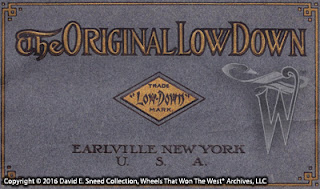With thousands of different types,sizes, and brands of early horse-drawn wagons used in America, studying this part of our past can sometimes be overwhelming. Thereare so many facets to the subject that we will likely never know every part of ourtransportation history. That said, thereis a great deal that we do know and much of that still has a way of going largelyunnoticed.
Patented designs, for instance, are notoften highlighted – even though the information is important to theunderstanding of a vehicle’s design, value, rarity, and overallprovenance. One example of what, today,might be looked upon as a common design is a series of business wagons built byJ.R. Parsons of Earlville, New York. Thecustom form was patented in 1890 and almost immediately referred to as a ‘Low-Down’wagon. To our 21st century way ofthinking, the term may sound derogatory, as though it was referring to aworthless or less-than-savory wagon experience. In this case, though, the name points to the low-slung, physical natureof the design. In fact, the phrase wasso defining it was trademarked by Parsons.
 |
| This logo was trademarked by the early 1890’s and used to heavily promote the namesake designs as being exceptionally comfortable, efficient, and profitable. |
Those with milk deliveries were amongthe biggest users of the unique designs. Some of these operators even claimed that the layout allowed them todeliver a third more milk in a given timeframe. Period sales literature touted the rewards of the design and claimedusers could benefit from time savings, convenience, comfort, and profitability. Many of the wagons were also equipped with apatented, ball-bearing fifth wheel that required no oil or grease - so it wasalways clean. The cut-under pattern wassaid to turn as easily when loaded as empty, so the user had no more worrieswith broken shafts and unnecessary strain on the horse.
Beneath the body, the forward portion ofthe gear was initially constructed with a reinforced A-frame support anddiagonal, elliptic springs on the front axle (later designs did not necessarily have theA-frame configuration). The upshot tothe plan was that it allowed the wagon to turn tighter without sacrificinginterior space, comfort, stability, and ease of access. The rear half of the gear utilized a regularplatform hung from irons that extended under the body. In essence, the wagon enjoyed great stabilitywith a series of smooth-riding, elliptic springs.
The bodies were fabricated from ash andoak while the wheels were said to be hickory with Sarven hubs and rivetedfelloes. Collinge collar steel axlesprotected the spindles and hubs from dust and grime while capacities on theselight-running wagons could range from 600 to 2500 pounds. Prices in the mid to late 1890’s werecompatible with medium and heavy capacity farm wagons, ranging from $130 tojust over $200.
While popular with the milkman, theParsons’ wagon was also readily adapted by those in the bakery, butcher,laundry, florist, department store, ice cream, and retail grocery businesses. Even so, if a person still wanted a moretraditional body mounted atop the axles, Mr. Parsons did offer a taller,straight sill wagon. Since those models had a highercenter of gravity and a much smaller turning radius, though, most folksgravitated away from the old style and readily adapted the new, ‘Low-Down’designs. Some will note that the companyactually had another, even earlier, wagon patent dating to 1888. This design innovation, though, utilized atapered body which affected interior space. This issue was overcome with the updated 1890 patent. So, top to bottom, that’s the low-down on the‘Low-Downs.’
Please Note: As with each of our blog writings, all imagery and text is copyrighted with All Rights Reserved. The material may not be broadcast, published, rewritten, or redistributed without prior written permission from David E. Sneed, Wheels That Won The West® Archives, LLC
Please Note: As with each of our blog writings, all imagery and text is copyrighted with All Rights Reserved. The material may not be broadcast, published, rewritten, or redistributed without prior written permission from David E. Sneed, Wheels That Won The West® Archives, LLC
